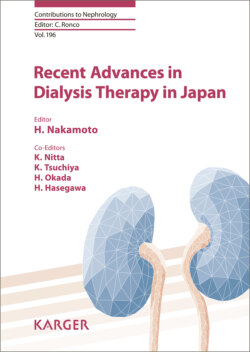Читать книгу Recent Advances in Dialysis Therapy in Japan - Группа авторов - Страница 98
На сайте Литреса книга снята с продажи.
Patients and Methods
ОглавлениеThis cross-sectional, observational study evaluated 148 uremic patients undergoing maintenance hemodialysis at a single center, the Fujii Clinic (Osaka, Japan). The study protocol was approved by the Ethics Committee of Wakayama Medical University (approval number 1300), and informed consent was obtained from all individual participants.
The hemodialysis treatment was performed 2 or 3 times weekly (4-h periods) with a standard bicarbonate-containing dialysate bath, using biocompatible membrane. Blood flow rates ranged from 200 to 300 mL/min, whereas the dialysate flow rate was kept constant at 500 mL/min. Clinical and laboratory data were obtained from each patient at the beginning of the first weekly hemodialysis session. Systolic (SBP) and diastolic (DBP) blood pressures were measured prior to dialysis. All patients were included, regardless of the reason for hemodialysis, age, sex, CKD etiology, or concomitant disease. Mean patient age at enrollment was 68.3 ± 10.5 years, and 46 patients (31.1%) had diabetes.
Patients were administered a phosphate binder, cinacalcet, and VDRA to achieve the target ranges for calcium (Ca, 8.4–10.0 mg/dL), phosphate (P, 3.5–6.0 mg/dL), and intact PTH (60–180 pg/mL), respectively, as specified in the Japanese Society for Dialysis Therapy guidelines [18]. Where indicated, i.v. maxacalcitol was administered at the end of each hemodialysis session, whereas an oral VDRA (alfacalcidol, calcitriol, or falecalcitriol) was administered daily in the morning. Serum FGF23 was measured prior to hemodialysis session.
